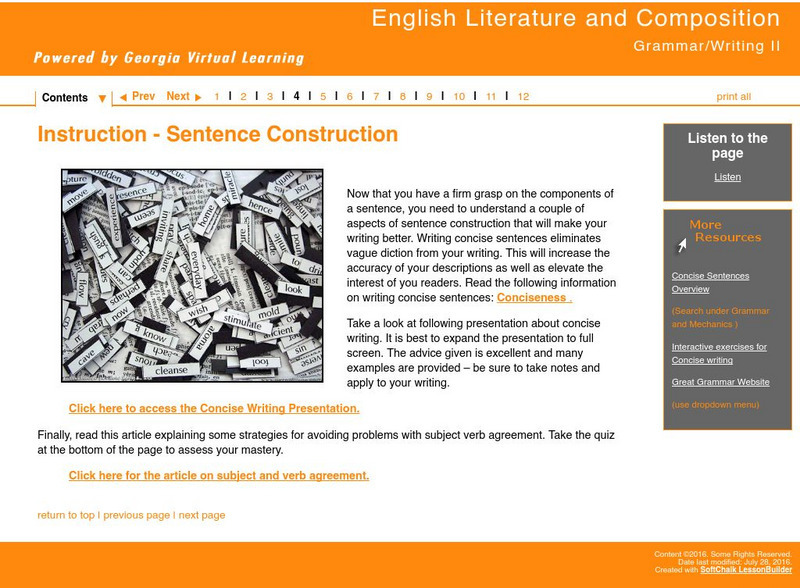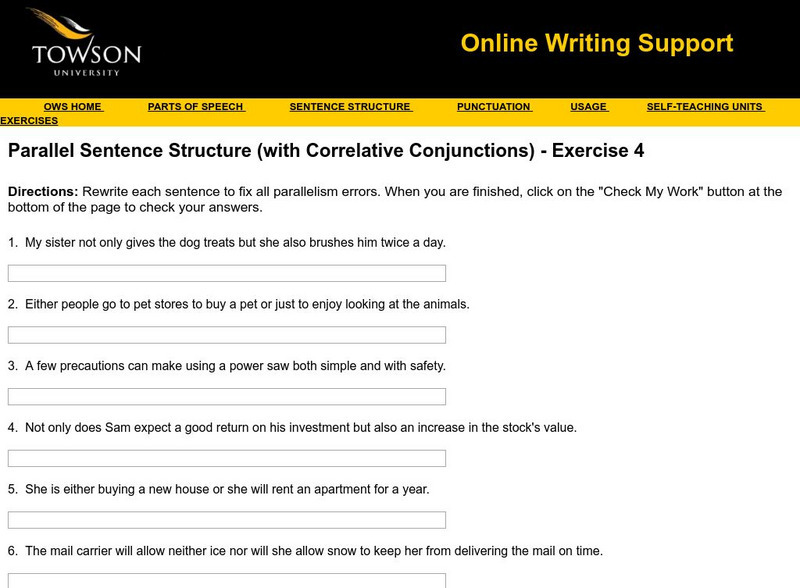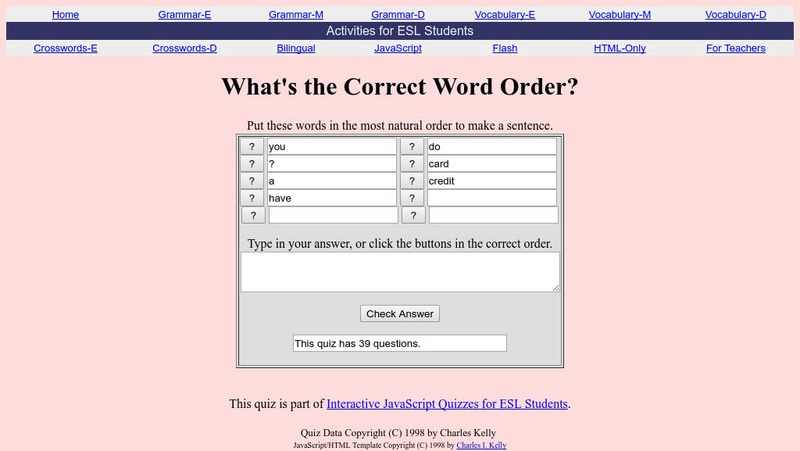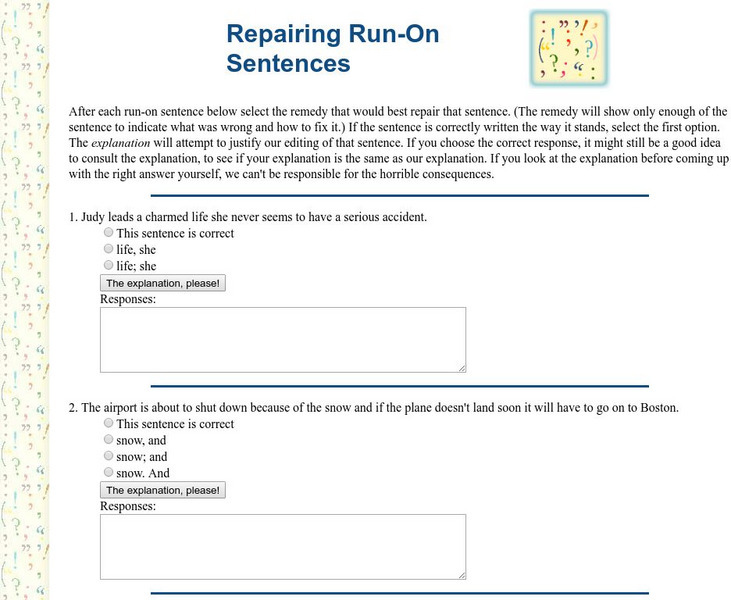Hi, what do you want to do?
Texas Education Agency
Texas Gateway: Use a Variety of Correctly Structured Sentences
A learning module that teaches students about varying sentence structure in six mini-lessons: Introduction; What Is a Sentence?; Simple Sentences; Readability: How Foggy Is Your Writing?; Compound, Complex, Compound-Complex, and The Art...
Texas Education Agency
Texas Gateway: Use a Variety of Correctly Structured Sentences
Learn to avoid fragments and run-on sentences while correctly combining clauses to create an effective variety of sentences, including complex, compound, and compound-complex.
Georgia Department of Education
Ga Virtual Learning: Ninth Lit and Composition:types of Writing: Sentence Errors
This lesson focuses on sentence errors like fragments, run-ons, comma splices, and fused sentences. It expains these errors, provides examples, and offers an interactive practice activity.
Savvas Learning
Pearson Longman: Sentence Resources for Writers: Overview of Punctuation
A grammar assessment for the high school student to practice recognizing and writing sentences with correct word use, punctuation and mechanics. Includes ten multiple choice questions that can be submitted to be scored and an essay...
Sophia Learning
Sophia: Correcting Run on Sentences and Comma Splices
A twelve-slide presentation explaining run-on sentences and comma splices and providing five solutions to correcting these sentence errors.
Georgia Department of Education
Ga Virtual Learning: Grammar/writing Ii: Instruction: Sentence Construction
This lesson from a grammar and writing unit focuses on sentence construction including writing clear, concise sentences useing the correct subject-verb agreement. It features links to The Writer's Handbook: Clear, Concise, Sentences,...
Texas Education Agency
Texas Gateway: Sentences: Compound, Complex, Compound Complex
[Accessible by TX Educators. Free Registration/Login Required] Use a variety of sentence structures including compound, complex, and compound-complex.
Capital Community College Foundation
Guide to Grammar and Writing: Using Colons Effectively Quiz
Interactive writing exercises. Click on "The sentence, please!" and a sentence will appear in the top text-area. Correct the sentence as needed by adding, removing, or moving the colon and rewriting as needed. Then click on "Grammar's...
Towson University
Towson University: Parallel Sentence Structure (W/ Correlative Conj) Exercise 4
This is a 10-question, self-grading exercise/quiz on correcting Parallel Sentence Structure using Correlative Conjunctions.
Towson University
Towson University: Ows: Parallel Sentence Structure Exercise 3
This is a 10-question, self-grading exercise/quiz on correcting Parallel Sentence Structure.
Sophia Learning
Sophia: Editing Techniques: Checking Your Sentence Structure
A ten-slide presentation demonstrating how to edit writing for sentence variety and how to identify and correct sentence errors such as fragments, run-ons, and comma splices.
Quia
Quia: Is This Sentence Correct?
This site offers a 30 question, interactive sentence quiz. Students are asked to read sentences, decide if they are correct as written, and then select a response. Java is required.
TESL Journal
Activities for Esl Students: Esl Quiz: What's the Correct Word Order?
In this ESL quiz, students click on words and end punctuation in the order needed to make correct sentences. There are 39 different sentences in this quiz. Java is required.
Capital Community College Foundation
Guide to Grammar and Writing: Quiz on Punctuation
Select the correctly punctuated sentence in each group. Then click on "Submit Application" for the self-monitoring answer key.
Sophia Learning
Sophia: Correcting Sentence Fragments: Lesson 1
This lesson goes over how to identify and correct sentence fragments. It is 1 of 4 in the series titled "Correcting Sentence Fragments."
University of North Carolina
University of North Carolina: Writing Center: Fragments and Run Ons
What are sentence fragments and run-on sentences? Explore this informative resource to review the meaning and some examples of these. Provides techniques for avoiding fragments and run-ons in writing assignments.
University of Sydney (Australia)
The University of Sydney: The Write Site: Unit 1: Sentence Fragments
A learning module with three lessons, four practice exercises, and a summary designed to teach what sentence fragments are and how they can be corrected.
Get It Write
Get It Write: To Split or Not to Split Infinitives
Here's a great discussion on whether or not to split infinitives. What is an infinitive, you say? This will tell you and will instruct you on whether it is ever correct to split one.
Texas Education Agency
Texas Gateway: Editing for Subject Verb Agreement
This lesson will provide some tips about how to locate and correct agreement problems; then students will have a chance to practice their skills and feel more confident about writing sentences with subjects and verbs that agree.
PBS
Pbs Learning Media: How to Use the Correct Capitalization
Capitalizing is extremely important. Not only is it proper writing, but it also makes writing look polished and finished. Learn what should be capitalized and what shouldn't! [0:53]
Roy the Zebra
Roy the Zebra: Reading Games: Does It Make Sense?
This reading game offers young readers the opportunity to correct a sentence and clean up trash on the seashore. They are to click and drag words in the correct order into a sentence so that it makes sense. Then they are to drag a piece...
Sophia Learning
Sophia: Avoiding Run on Sentences and Comma Splices
This lesson goes over how to correct a run-on sentence or a comma splice.
Capital Community College Foundation
Guide to Grammar and Writing: Repairing Run on Sentences
An exercise with ten sentences to help students identify and correct run-on sentences. Students read the sentence and then click on the answer choice that corrects any errors in the sentence. After making their choice, students can see...
Other
D'youville College: Core Parts of a Sentence
This online writing lab provides a series of examples on identifying one of the two main components of complete sentences, the subject and the verb. Correctly identifying these parts will result in the ability to write complete sentences.



























